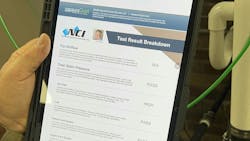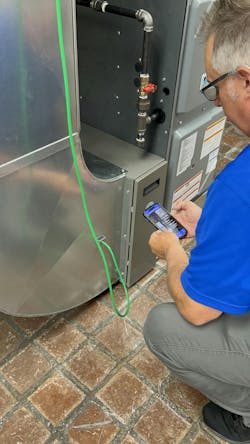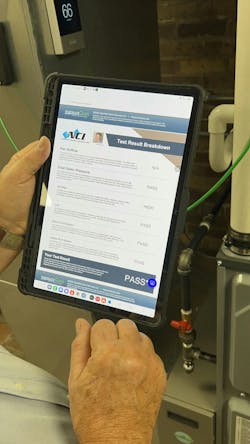Nothing is more frustrating than installing a new piece of equipment only to have problems from the time you start it up. However, these issues may have nothing to do with your installation. Instead, you may have inherited someone else’s bad duct installation you attached the new equipment to. By doing that, you now own the resulting airflow problems.
Estimates are that nine out of 10 homes have some type of duct system issue that could negatively impact new equipment. Unless you address these issues before the installation, you own them. Instead of dealing with resulting breakdowns and callbacks, why not turn existing bad installations into opportunities? You can with a pre-packaged airflow solution called an Air Upgrade™.
National Comfort Institute (NCI) has been promoting this concept for over a decade. But recently we partnered with The Energy Conservatory (TEC) and measureQuick (mQ) to digitize and streamline the process. Most of us were never taught how to diagnose or solve airflow problems. When we tried, it often looked like a mix between duck-duck-goose and a science project. It doesn’t have to be that way.
An Air Upgrade is a set of predetermined, flat-rate airflow improvements.
In the first of this six-part Air Upgrade series, we’ll look at what an Air Upgrade is, why it’s important, what’s included, and how you can find opportunities for them. In future articles we’ll go deeper into details to paint a clearer picture of this approach. There is a better way to improve duct systems and solve the accompanying problems that your customers will be delighted to pay for.
What’s an Air Upgrade?
An Air Upgrade is a set of predetermined, flat-rate airflow improvements. It’s a plug and play product you can easily incorporate during most equipment replacements as part of a better package, or as a standalone solution. They’re a great fit for anywhere there is limited duct system access, like a finished basement or multi-story home. However, NCI designed them to work on just about any forced air HVAC system and not add much time to a job.
The goal of an Air Upgrade is to achieve static pressure at or near manufacturer specifications, and fan airflow within ± 10% of required airflow. To discover Air Upgrade opportunities, you start with simple diagnostic testing that any service technician or salesperson can do. They simply measure static pressure and fan airflow. A visual inspection may reveal obvious problems, but field measurements put data behind these observations. The TEC and mQ apps take this one step further and codify a step-by-step process that’s easy to follow.
Why is an Air Upgrade Important?
In a time when most HVAC contractors seem the same and use similar marketing approaches, Air Upgrades provide a unique way to differentiate yourself from other companies. They have no set market value, and the price cannot be shopped. The end-product results in uniquely high profits with no competition.
Since Air Upgrades solve fan airflow and static pressure problems, you will have fewer callbacks and much happier customers. It’s a lot easier to keep profits in your company than letting them drip away in unnecessary callbacks. Technicians can have the confidence to recommend the right solutions instead of trying to tweak the equipment or make excuses. It’s freeing when they know problems aren’t in the equipment, can confidently identify them, and then explain the results to the customer.
Air Upgrades remain hidden until your testing and diagnostics make them visible. You create the demand for this unique product. Most customers have problems that Air Upgrades cure, however, they often can’t make the connection until you help them understand. Since Air Upgrades allow equipment to perform as intended by the manufacturer, they also get the bonus benefit of brand and reputation protection.
What Does an Air Upgrade Include?
Because Air Upgrades focus on improving static pressure and fan airflow, the air-moving equipment receives much of the attention. However, that shouldn’t stop you from making repairs to the duct system, as needed. Here are some of the most common Air Upgrade improvements listed by location.
- Rework filter system to reduce filter pressure drop
- Improve and enlarge equipment duct connections
- Increase return drop size
- Perform basic system cleaning
- Test, adjust, and set fan speed
- Readjust refrigerant charge
- Verify combustion safety.
- Add one oversized return duct and grille into a large open area
- Replace three or more six-in. supply ducts with eight-in. ducts and balancing dampers
- Seal accessible duct leakage to reduce airflow loss
- Add strapping to properly support the flex duct system
- Replace restrictive duct fittings
- Upgrade grilles and registers from builder grade.
There are times an Air Upgrade won’t be enough to do the job. Your customer may want a higher level of comfort that requires work beyond the pre-packaged repairs in an Air Upgrade. Don’t limit your offerings to the Air Upgrade package alone. Instead, use it as a solution to the most common airflow and duct system problems.
How to Find Air Upgrade Opportunities
You can find Air Upgrade opportunities using four simple steps. It’s likely you’re already doing many of these things anyway. You just haven’t structured them into a repeatable process that gets the results you want.
Start with a visual inspection. Look at equipment cleanliness, blower wheel condition, and any obvious duct system defects. You typically recognize the problems when you see them. Be sure to take lots of photos of potential problem areas.
Next, gather basic equipment information. Look at the indoor and outdoor nameplates for model and serial numbers. On the indoor equipment nameplate, pay special attention to the rated total external static pressure (TESP). Other items to consider are fan speed settings, heating and cooling capacity, and fan airflow capacity.
Once you’ve done an inspection, measure and diagnose static pressure. This usually includes four pressure measurements at the air-moving equipment. From these measurements, you’ll test TESP, filter pressure drop, coil pressure drop, and duct system pressures. The TEC NCI Workflows and mQ AirMaxx Quick Tests walk you through the testing and aid in diagnostics using built in NCI static pressure budgets.
After performing static pressure testing, it’s best to measure or plot fan airflow. Static pressure testing alone is limited in the information it provides. However, once you add fan airflow, it takes your diagnostics to another level.
There are two quick ways to check fan airflow. The first is a direct measurement with the Digital TrueFlow from TEC. It’s a great test instrument suited for a selling technician or comfort advisor. The second is plotting fan airflow with TESP and a fan table. It’s a great option for service and maintenance technicians. While not as accurate, it will identify major discrepancies in airflow and serve as a red flag for airflow and duct system issues.
Once you have your measurements, discuss the findings with your customer. You can ask initial diagnostic questions about uncomfortable rooms, dust, utility bills, and equipment problems based on your test results. A simple way to help a customer understand these connections is to show results from the mQ or TEC generated reports. They act as third-party proof of your findings. If everything works well, you’re solving the customer’s problems and getting paid handsomely for it.
Are Air Upgrades Right for You?
Think about whether this product and approach are a fit for your company. If you’re content swapping boxes like-for-like and the way you do business works for you, keep on. However, if you’re fed up with callbacks and looking for a way to differentiate yourself, Air Upgrades may be just what you need. This approach is like the same one we used to save our family company. We separated ourselves by solving problems others overlooked and thought were impossible to fix. You can have the same confidence your duct repairs will work with the Air Upgrade process.
Look for the remaining articles in this series as I focus on each step of the Air Upgrade process at a time. I hope these articles will help you steadily improve your installs and make HVAC fun again.
David Richardson serves the HVAC industry as vice president of training for National Comfort Institute, Inc. (NCI). NCI specializes in training that focuses on improving, measuring, and verifying HVAC and Building Performance.
If you’re an HVAC contractor or technician interested in learning more about Air Upgrades, contact David at ncilink.com/ContactMe. NCI’s website www.nationalcomfortinstitute.com is full of free information to help you improve your professionalism and strengthen your company.
About the Author
David Richardson
Director, technical curriculum
David Richardson serves the HVAC industry as director of technical curriculum at National Comfort Institute, Inc. (NCI), Avon, Ohio. NCI specializes in training that focuses on improving, measuring, and verifying HVAC and Building Performance.


